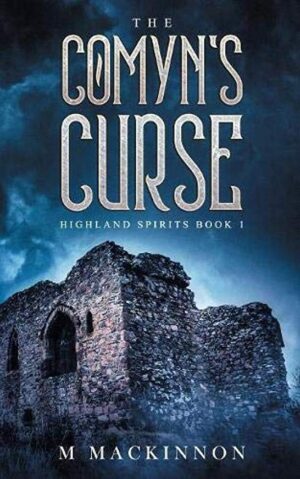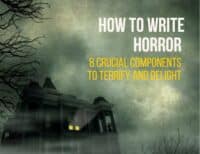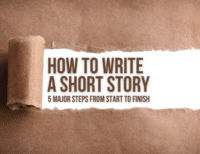Writing fiction with paranormal elements can be tricky, especially in a modern setting. You want your readers to suspend their disbelief and just go with the story. You don’t want them to roll their eyes because the concept of your paranormal world is too far-fetched. Today we're talking with paranormal romance writer M MacKinnon to get her take on writing paranormal fiction.

How to Write Paranormal Fiction
Paranormal elements in a story should be necessary and seem natural within the confines of the setting and plot. The paranormal should fit in because it feels right and makes sense for the plot of the story, not because you're trying to jump on a popular trend.
Paranormal fiction is a genre I fell in love with at a young age, so I was super excited to talk with this month’s interviewee to discuss how she developed her paranormal romance series, The Highland Spirits Series.
M MacKinnon is the author of The Comyn’s Curse, a paranormal romance set in Scotland. She began her writing career with Downton Abbey fanfiction. Eventually, she found The Write Practice and completed the first draft of her novel in our 100 Day Book course last year. The Comyn’s Curse is out in select bookstores and online merchants as of today.
You can get in touch with M MacKinnon via her website (where she offers a free short story for signing up for her email list), Facebook, or Twitter.
Now let’s dive into MacKinnon’s paranormal world!
Congratulations on the release of your first novel, The Comyn’s Curse! Tell me a little about the book and the series it opens.
I had no idea what paranormal romance is. After my first stay (a month) in Inverness, Scotland, I came home with a driving urge to write something about the magic of the Scottish Highlands. I did some research on legends and found the legend of the handless ghost who is said to haunt Rait Castle, near Nairn.
Something about the one paragraph synopsis (it was all I could find anywhere) called to me, and I became quite irate on behalf of the ghost. She had no name and in some tales wasn’t even a woman! So I decided to write her story, give her a name and a romance, and draw a parallel between the woman who had lived and died in 1442 and a fictional American girl from New Jersey, who is her descendant.
The book is my love affair with Scotland, its history and mysteries.
Part way through the plotting of The Comyn’s Curse, I knew that there would have to be more—the story just had to continue. So I decided to make it a trilogy and dedicate the next two novels to Aubrey’s two best friends who had supported her through her travails.
The second features her friend Kate, a police detective, and the third is about her friend Colleen, a nurse. Each will have a real legend from the past, each will involve the girls traveling to Scotland and finding love in the Highlands, and each will have a mystery and danger beyond the ghost story. The Piper’s Warning, Kate’s story, is in second-draft phase, and The Healer’s Legacy, Colleen’s tale, is plotted and about three chapters in.
I’m glad I made the decision, because I love my characters, including my ghosts, and I want to do right by them.
The novel takes place primarily in Scotland. I know you visited the country to do research. Can you talk about your research process a bit?
 I really didn’t start my research until I came home, because the idea for the story didn’t come until then, but I was able to incorporate a lot of information gleaned as a tourist and quite a bit from the books I bought while there. I’m a huge history nut, and I tend to haunt bookstores. (See what I did there?)
I really didn’t start my research until I came home, because the idea for the story didn’t come until then, but I was able to incorporate a lot of information gleaned as a tourist and quite a bit from the books I bought while there. I’m a huge history nut, and I tend to haunt bookstores. (See what I did there?)
My research on Rait, a ruined hall castle outside Nairn, came about first through a Facebook group called “Save Rait Castle”. When we went back last August for our second visit, I went first to the members of that group, who are passionate about the preservation of what’s left of the castle, and asked if anyone would be willing to guide my husband and me on a pilgrimage to the castle.
We met a wonderful Scottish gentleman named Victor Cameron, who has an acknowledgment in the book, got to know him, and spent an amazing day touring the castle I had written about for almost four months! A truly emotional experience. In fact, I stood in the doorway of the castle and cried.
If you couldn’t have visited, how would you have gone about researching?
I would have had to rely on the library and my bookstores, as well as social media sites like the one I found. I probably wouldn’t have written a book based in Scotland, though, if I hadn’t been there to experience its magic.
The Comyn’s Curse is a paranormal romance novel that has a backdrop containing real places and current events. How do you weave paranormal elements into a modern story? What techniques do you use to walk that fine line between a reader’s suspended disbelief and being too far-fetched?
Well, I knew I needed to have a modern romance in order to make the story click, and I wanted to make the life (or afterlife) of my ghost a bit more pleasant than history did, so I decided to create a parallel between the two main characters in the book, with Aubrey, my protagonist, unknowingly being the descendant of the Rait Castle ghost. The curse was created in order to give a reason for the ghost to be hanging around, with Aubrey being the solution she has sought for almost seven hundred years.
I had both my modern protagonist and her ultimate love interest come together in a purely normal way, but then find that each was descended from one of the lovers of the past. The paths of both couples intersected at key points in the book.
What made you decide to include paranormal elements in this story? Did you want to go in that direction from the start?
Yes, the story started with the real legend of the ghost with no hands. I couldn’t find any more than a paragraph on her, anywhere, but something about her fate called to me and I felt I had to give her a better life (or afterlife) than she had received in that one paragraph.
Even the castle is forgotten by many Scots who live very near it; they’d never heard of Rait Castle in the book store at the local Inverness mall! It just seemed wrong. I’ve righted history, and I think the ghost is very grateful.
Do you like to stay within paranormal canon, or make up your own ‘rules’ for your paranormal elements?
Well, funny you should ask! The first (and only!) time I pitched the book was to a young agent who told me that she didn’t think my book was paranormal romance at all, and she should know because she dealt primarily with that genre.
I was fairly devastated because I suddenly felt “genre-less,” but other authors told me to stick with my own thoughts on my own story, and fortunately I did. I was somewhat relieved to see in the Kirkus review that my work was a “pleasing cross-genre novel” that had “something for everyone.” It explained a lot.
That’s tough to hear that from an agent. Did you think of cutting the paranormal elements to make it “fit” better in a genre?
No, I was never going to give up my ghost! I just felt that it was my fault that I hadn’t sold the concept in a pitch which lasted five minutes. The whole idea of trying to sell a book which includes history, romance, ghosts, and conspiracy in a few minutes was daunting, and frankly, I thought it was ridiculous.
What I did think about was how to find the genre in which the story fit best, and as I said to that agent, “well, it has ghosts, and romance, doesn’t it? How can that not be paranormal?”
She had no answer, which was fine with me.
Is there anything about writing the paranormal that was more difficult than sticking to reality?
No, since the paranormal part of the story was actually real history, that was the easiest part. Making it fit the modern era was a bit more difficult, but as soon as I met Aubrey, my protagonist, everything fell into place. It just seemed right.
You also have some espionage and mystery thrown in there. Can you talk about your plotting process?
I decided fairly early in the plotting that I would have not only the parallel stories of the past and present romances, but a mystery as well, because . . . well, I love mysteries. So I researched Brexit and invented a villain who was conspiring to undermine the new surge toward a second referendum for Scottish independence in the wake of Brexit.
I decided to structure the novel into “books” or parts, each beginning with a short piece from 1442, then two modern chapters, a modern “conspiracy” chapter from the POV [point of view] of the antagonist, and then two more modern chapters. The three stories parallel each other until the end, when they all come together in a climactic series of events.
What’s one thing you’ve struggled with in your writing and how did you overcome it?
I think the main struggles have been with the mechanics faced by beginning authors, such as head-hopping, show don’t tell, and over-use of proper English. (I was an English major, and the idea of not using semicolons when two independent clauses are put together was very difficult to overcome at first!)
I also tend to edit as I go, rather than just writing and then going back to it later, which can cause thesaurus headaches and insomnia as I lie there rewriting in the darkness, but I’m not sure that’s such a bad thing. I suspect it’s just my style.
Any other advice you’d like to give aspiring writers out there?
Any chance you have to join a writer’s group like The Write Practice, any courses like 100 Day Book or NaNoWriMo, DO IT! Don’t let anyone tell you that you don’t have it in you, or that your story shouldn’t be told. Find a good editor and be accepting of his/her advice—there’s a reason they’re in that business.
My most fervent advice is to find other authors and share, critique and allow yourself to be critiqued. The more you help others with their writing, the more they’ll invest in yours, and everybody wins! I’ve made some amazing friends doing this, and I don’t think I’d be looking at the launch of my first novel in a three book series without them.
What’s next for you?
After the launch of The Comyn’s Curse, I’ll refine and submit The Piper’s Warning, probably this summer. While that is going on I’ll dive back in head first to The Healer’s Legacy.
I have a YA fantasy novel, Slither, which is five chapters in and waiting patiently on the shelf for this Scottish stuff to be finished (I haven’t the heart to tell those characters that it may never be finished), and I fully intend to get back to that at some point.
I do think that fantasy and paranormal romance are my forte, but I’ll be staying in that genre, but I love mystery and may someday write a thriller too. Who knows? It’s part of the joy of writing, isn’t it?
Your Turn to Write Paranormal Fiction
Not sure where to start writing paranormal fiction? Try taking an obscure legend or myth and turning it into the basis for your next story. Be sure to make the paranormal elements necessary to the story, so that without them, it couldn't work as it does.
Who knows—your paranormal story might just send you traveling the world!
M MacKinnon would like to thank Meghan McKeever of New York Book Editors and DartFrog Books for their support in getting her work into readers’ hands. The Comyn’s Curse is available now on Kindle and in paperback. And stay tuned for the remaining books in the series!
How do you keep paranormal fiction elements “realistic” enough for your readers? Let me know in the comments!
PRACTICE
Today, I want you to take fifteen minutes to write on the following prompt:
A (normally very logical) friend calls you and says they've seen a ghost in their house. They were able to communicate with it, they know why it's there, and want your help getting rid of it. Who is this ghost and why is it there? What do you do?
Share your paranormal fiction story in the comments and don't forget to comment on your fellow writers' work!







0 Comments